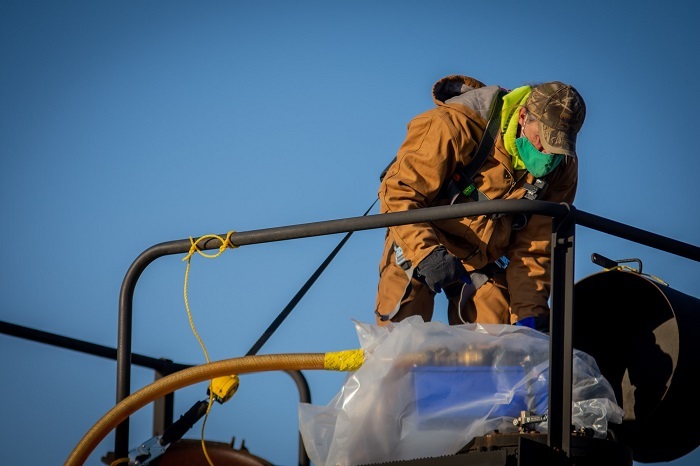 Paducah Site worker Cayce King connects a hose to a rail car to drain oil from the C-531 switchyard. Each rail car can hold approximately 25,000 gallons of oil.
PADUCAH, Ky. – EM’s Paducah Site recently transferred approximately 210,000 gallons of electrical insulating oil to support economic development in the region.
The Paducah Area Community Reuse Organization (PACRO) will reuse or recycle the oil from the Paducah Site’s C-531 Switchyard to provide a revenue stream for economic development in the Kentucky counties of McCracken, Ballard, Marshall, and Graves, and Massac County in Illinois.
“The funds generated from the sale of this oil will help boost economic development efforts in our region,” PACRO Executive Director Greg Wiles said. “The partnership PACRO has with DOE allows us to create value to our communities by reusing materials or generating revenue from the sale and recycling of excess property and equipment. We are fortunate to have this partnership in place.”
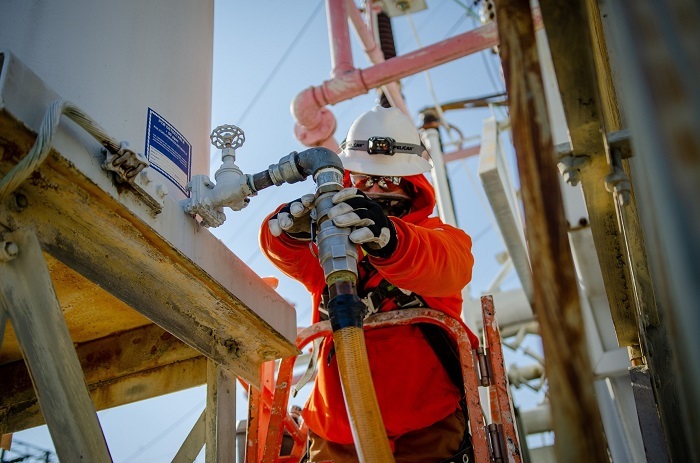 Paducah Site worker Matt Gill hooks up a hose to a switchyard electrical component to pump oil into rail cars for transfer to the Paducah Area Community Reuse Organization.
During its peak uranium-enrichment operations, the former Paducah Gaseous Diffusion Plant (PGDP) used four switchyards to provide power to its four large process buildings. Power could be routed through one of more than 90 oil-filled circuit breakers to oil-filled transformers located in the switchyards. The transformer oil acted as an insulator and cooling agent in the system.
EM is committed to community partnerships and works to ensure excess items are made available to PACRO for economic development when appropriate, according to EM Paducah Site Lead Jennifer Woodard of the Portsmouth/Paducah Project Office.
She added that EM is also working to reduce overall utility costs and minimize utility distribution systems no longer needed. Since the Paducah Site began deactivating the switchyards, more than 500,000 gallons of transformer oil has been transferred to PACRO.
“Part of our mission at the Paducah Site is to reduce waste and to ensure we are good stewards of the environment,” Woodard said. “This effort includes finding ways to reuse or recycle materials no longer needed at the site. This stewardship provides an added benefit to our community through PACRO.”
 Paducah Site workers monitor progress as oil is drained from the C-531 Switchyard into a railcar for transfer to the Paducah Area Community Reuse Organization. The transfer required the use of nine rail cars containing a total of approximately 210,000 gallons of transformer oil.
The C-531 Switchyard is the last of Paducah’s electrical switchyards to be shut down. It has been replaced by a more energy efficient substation powered and monitored by the Tennessee Valley Authority, a corporate agency of the U.S. that provides electricity for business customers and local power companies, serving 10 million people in parts of seven southeastern states.
Four Rivers Nuclear Partnership (FRNP), EM’s deactivation and remediation contractor, will complete the final steps to deactivate the switchyard this summer.
“Since PGDP ceased operations in 2013, electricity needs at the Paducah Site have reduced significantly,” FRNP Program Manager Myrna Redfield said. “The switchyards were designed to deliver up to 3,000 megawatts per hour. Today, the site only requires about 10 megawatts per hour. Deactivating the switchyards allows DOE to advance its cleanup mission.”
-Contributor: Dylan Nichols
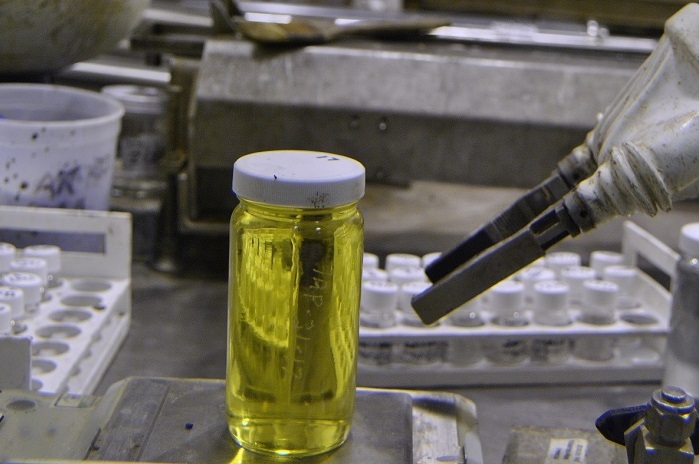 Hanford contractor Washington River Protection Solutions and contractor Bechtel National, Inc. subcontractor Waste Treatment Completion Company both play a critical role in making sure tank waste meets the requirements for treatment and subsequent processing at Hanford’s Waste Treatment and Immobilization Plant. Pictured is a waste sample taken as part of the site’s waste feed qualification program.
Hanford contractor Washington River Protection Solutions (WRPS) and contractor Bechtel National, Inc. (BNI) subcontractor Waste Treatment Completion Company (WTCC) have been working together to qualify waste as part of Hanford’s Direct-Feed Low-Activity Waste (DFLAW) approach to treating tank waste. Each company plays a critical role in making sure the tank waste meets the requirements, or qualifies, for treatment and subsequent processing at Hanford’s Waste Treatment and Immobilization Plant (WTP). Vitrification is a process in which tank waste is immobilized in glass. WRPS Waste Feed Delivery and Operations Planning Manager Peter Benson started establishing the qualification process about 10 years ago when he worked at the WTP. Now Benson is establishing parallel parameters in coordination with WTCC and Bechtel.
“Every tank has waste with a different chemical makeup, and we need to know what that is before we can treat it,” Benson said. “We can effectively immobilize waste in glass by adapting our process to each tank.”
The reason for the complexity of the waste at Hanford when compared to other EM sites is due to the different chemical processes that were used to separate plutonium during Hanford’s production lifetime. That complexity carries into the vitrification process, requiring different recipes for the vitrification materials, depending on the contents of the waste.
“We sample the waste at the tank farms, comparing it to a set of requirements to determine whether we need to make any modifications to the waste on our end before we move forward with treatment,” said Michelle Molina, WTP engineer for process chemistry.
 During Hanford’s tank waste feed qualification program, glass pucks such as the one pictured in the lower portion of this photo are produced using the feed material from the sampling that has undergone lab-scale processing.
Workers at the 222-S Laboratory, operated by EM contractor Hanford Laboratory Management and Integration, are tasked with analyzing and testing waste samples. Once the waste is fed to the WTP, the plant’s Analytical Laboratory team will sample and analyze it again to ensure it will meet the glass product requirements.
The joint waste qualification process is an example of how separate contractors can work together successfully.
“Both sides have fully embraced the need to do this,” Trevor Kilgannon, WTCC plant engineering flow-sheet integration manager said. “This is just another sign of progress — shared progress among Bechtel, WTCC, and WRPS — as we move forward with the DFLAW concept, with contractors mindful that waste treatment through WTP is a common goal for the Hanford Site.”
Benson agrees, saying there are many groups that contribute to the waste feed qualification effort.
“The effort requires a significant amount of coordination among the organizations, from the tank waste inventory and characterization group that plans the sampling and analysis, to sampling operations that pulls the samples, as well as process engineering, waste feed delivery and operations planning, and WTCC flowsheet integration, who all have downstream activities as part of the program,” Benson said. “Implementing the DFLAW approach to waste feed delivery will be a true Hanford accomplishment.”
-Contributor: Jenna Kochenauer
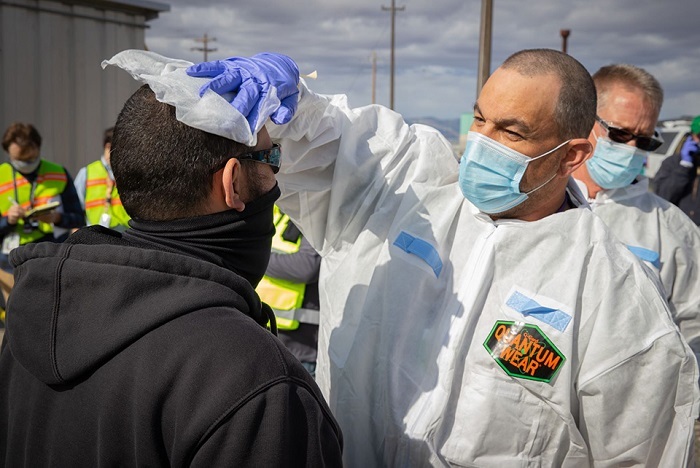 Emergency response teams on the Hanford Site simulate the treatment of an injured worker as part of an annual exercise that also utilized the site’s Emergency Operations Center.
RICHLAND, Wash. – A wide range of employees recently contributed to the success of an emergency response exercise on the Hanford Site, reacting to a scenario that included contamination and a take-cover alert.
EM Richland Operations Office (RL) contractor Hanford Mission Integration Solutions (HMIS) emergency management professionals planned the exercise, ensuring COVID-19 safety protocols were met while using Hanford’s Emergency Operations Center (EOC).
Employees from EM and all contractors at the site participated. They had no prior knowledge of the scenario, allowing them to make decisions with the same limited reaction time posed in an actual emergency.
Exercises of this kind typically happen annually on the Hanford Site to keep response skills sharp and ensure the swiftest reaction to keep people, property, and the environment safe.
“Practicing our response to disaster scenarios serves as an important tool in the safety toolbox on the Hanford Site, preparing our workforce for potential emergencies,” RL Security, Emergency Services, and Information Management Division Director Tim Haddick said. “An annual exercise builds our proficiency, and helps us assess our performance and identify opportunities for improvement.”
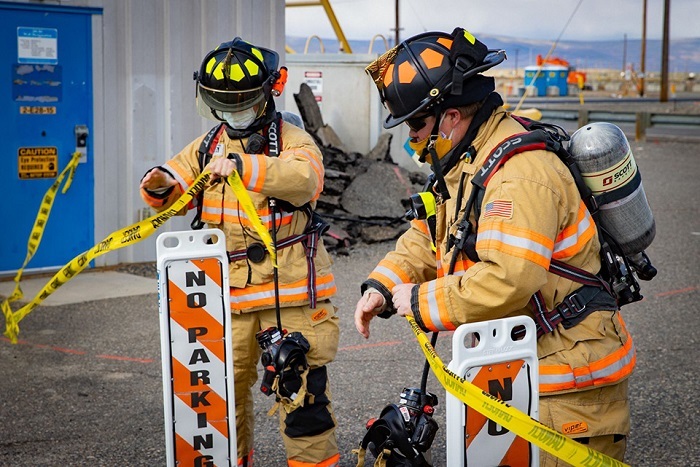 Members of the Hanford Fire Department take part in an emergency exercise on the Hanford Site, simulating a contamination and take-cover alert.
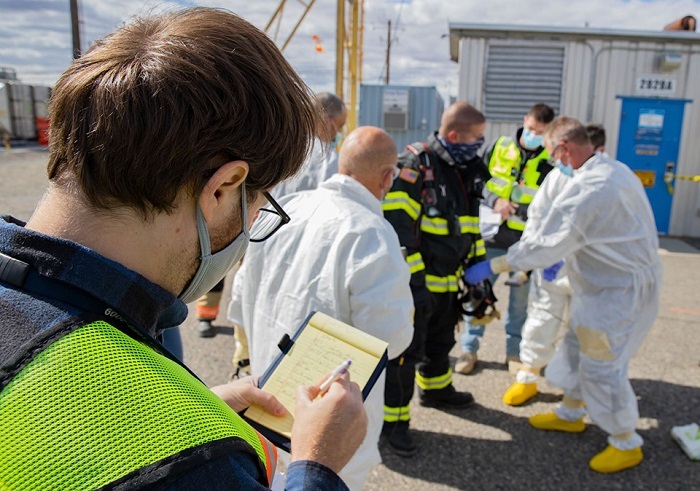 Employees from EM and contractors on the Hanford Site maintained COVID-19 safety protocols while taking part in an annual emergency exercise.
This year’s scenario simulated a vehicle hitting a facility that stores radioactive filters. This resulted in a hazardous material operational emergency in which exercise participants responded to a mock release of contamination.
Hanford’s fire department triaged the staged accident and treated the vehicle occupants, transporting one actor to a medical facility for simulated treatment and decontamination.
At the EOC, local, regional, and state emergency operations professionals, and other organizations, joined the exercise. All who took part maintained COVID-19 safety protocols while serving in varying roles related to the emergency response, including keeping the public informed of potential danger.
“You never want to wait until the real thing to have your emergency response preparedness put to the test,” said Lorie Blehm, HMIS deputy vice president for safeguards, security and emergency response. “This yearly exercise builds confidence in our ability to react to a wide range of potential occurrences on the Hanford Site.”
In addition to the annual sitewide exercise, HMIS conducts limited exercises and training throughout the year for various response teams and situations.
-Contributor: Robin Wojtanik
 Workers demolish a section of the metal roof over the Ford Building at the Savannah River Site. At the height of the Cold War, the facility was used to test components used in five nuclear reactors at the site.
AIKEN, S.C. – The Savannah River Site (SRS) management and operations contractor received an overall rating of “excellent” and nearly $45 million — or 96% of the available fee award — for its performance from Aug. 1, 2019 through Nov. 30, 2020.
EM releases information relating to contractor fee payments — earned by completing the work called for in the contracts — to further transparency in its cleanup program.
Savannah River Nuclear Solutions (SRNS) continues to deliver strong operating performance while maintaining high standards for safety, safeguards, and security, according to the fee determination scorecard. During the performance evaluation period, SRNS completed several significant activities:
- Responded to the COVID-19 pandemic by activating the Infectious Disease Response Team; communicated thoroughly and promptly throughout the pandemic; contracted with Augusta University to conduct testing onsite; established a rapid testing facility onsite; instituted a COVID-19 hotline; and tracked employee COVID-19 testing.
- Awarded nearly 80% of its subcontracts to small businesses, exceeding its goal of 55%.
- Provided excellent support to DOE-Savannah River (SR) in communications with Ameresco for steam production and delivery, and Dominion Energy for electrical distribution and adjustments to required maintenance outages to adapt to COVID-19 restrictions while meeting site mission requirements.
- Completed all regulatory milestones and commitments on or ahead of schedule, including 99 Federal Facility Agreement Appendix E and Resource Conservation and Recovery Act permit milestones; management of more than 600 site permits; collection, analysis, and reporting of more than 10,000 environmental samples on- and offsite, including samples of air, water, vegetation, soils, dairy, fish, and wildlife.
- Completed infrastructure upgrades to increase internet bandwidth speeds onsite.
View the SRNS fee determination scorecard here.
|